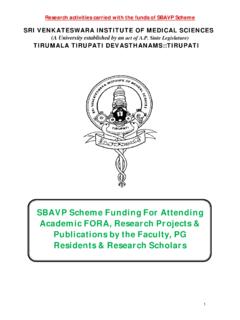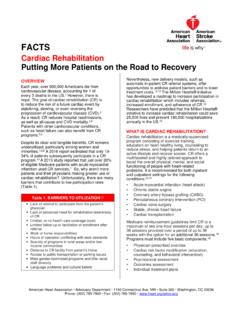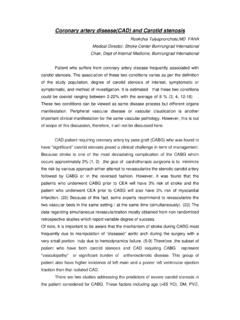Transcription of Guidelines for Blood Product Use - …
1 Clinical Practice Recommendations- Quality Improvement Plan Toolkit Ver March 2016 CLINICAL PRACTICE RECOMMENDATIONS FOR Blood COMPONENT USE IN ADULT INPATIENTS These Clinical Practice Recommendations were compiled from a review of evidence-based Guidelines , Choosing Wisely and Choosing Wisely Canada lists, the current literature, selected hospital transfusion Guidelines , and expert opinion. Because a formal literature search was not part of the preparation of these recommendations, they are presented as recommendations rather than Guidelines . These recommendations are intended to assist hospitals that are in the process of developing their own Guidelines , or have yet to develop Guidelines . They are not intended to replace existing hospital Guidelines , although they may provide additional updated information for those hospitals that have already introduced locally-approved Guidelines . Disclaimer The Clinical Practice Recommendations for Blood Use in Adult Inpatients are not intended to replace sound clinical judgement concerning a patient s unique situation.
2 Furthermore, although the advice and information included in these recommendations is believed to be true and accurate at the time of publication, neither the authors nor the publishers can accept any legal responsibility for any errors or omissions that were made. Clinical Practice Recommendations- Quality Improvement Plan Toolkit Ver March 2016 Red Cells Clinical Setting Recommendation and dose Hb less than 60 g/L Transfusion likely appropriate*. Transfuse 1 unit and re-check patient symptoms and Hb before giving second unit. Hb less than 70 g/L Consider transfusion. Transfuse 1 unit and recheck patient symptoms and Hb before giving second unit. Hb less than 80 g/L Consider transfusion in patients with pre-existing cardiovascular disease or evidence of impaired tissue oxygenation. Transfuse 1 unit and recheck patient symptoms and Hb before giving second unit. Hb 80 to 90 g/L Likely inappropriate unless evidence of impaired tissue oxygenation.
3 Hb greater than 90 g/L Likely inappropriate. If transfusion is ordered clearly document indication in patient s chart and discuss reason with patient. Bleeding patient Maintain Hb greater than 70 g/L If pre-existing cardiovascular disease maintain Hb greater than 80g/L Hb = hemoglobin * Depending on etiology of anemia, alternative therapies ( iron) may be more appropriate than transfusion. One unit usually raises the Hb by approximately 10 g/L. Do not transfuse based on Hb value alone. Transfusion of RBC is indicated in the treatment of symptomatic anemia. For non-bleeding patients: usual adult dose is 1 unit: transfuse 1 unit then check Hb and patient symptoms (dyspnea, chest pain, syncope) before transfusing a second unit. Premedication for allergic and febrile reactions is usually indicated only in patients with previous transfusion reactions. Consider premedication with furosemide in patients at risk for transfusion-associated circulatory overload.
4 It is preferable to give furosemide before the transfusion if the patient is not hypovolemic and is hemodynamically stable. Whenever possible, all non-urgent transfusions should be completed during the day shift, for optimum patient safety. Clinical Practice Recommendations- Quality Improvement Plan Toolkit Ver March 2016 Platelets Clinical Setting Recommendation and dose Diagnosis/Indication Platelet Count x 109/L Non-immune thrombocytopenia Less than 10 1 dose Procedures not associated with significant Blood loss, including percutaneous procedures other than epidural anesthesia or lumbar puncture Less than 20 1 dose Therapeutic anticoagulation that cannot be stopped Less than 30 1 dose, and consult thrombosis specialist Epidural anesthesia or lumbar puncture Procedures with expected Blood loss greater than 500ml Major non-neuraxial surgery Significant bleeding Less than 50 1 dose.
5 Immediately before procedure and check platelet count before starting procedure Neuraxial surgery Head trauma or CNS hemorrhage Life-threatening hemorrhage Less than 100 1 dose and check platelet count Platelet dysfunction and significant bleeding ASA, clopidogrel therapy, post cardiopulmonary bypass any 1 dose Immune thrombocytopenia (ITP) case specific 1 dose, for life-threatening bleeding only and consult a hematologist Transfusion of platelets is indicated for prophylaxis against bleeding or for management of acute bleeding in patients with thrombocytopenia or platelet dysfunction. In general 1 dose raises the platelet count by approximately 15-25 x 109/L. 1 dose = 1 buffy coat pool or 1 apheresis unit. Clinical Practice Recommendations- Quality Improvement Plan Toolkit Ver March 2016 Plasma Clinical Setting Recommendation and dose Diagnosis/Indication INR Significant bleeding Liver disease with coagulopathy and invasive procedure planned (see Notes below) Greater than 3-4 units Microvascular bleeding Massive transfusion Greater than to or unknown and cannot wait for result 3-4 units Urgent warfarin reversal and o Serious bleeding o Urgent surgical procedure required within 6 hours Greater than Do not use plasma unless prothrombin complex concentrate (PCC) is not available or is contraindicated ( history of heparin-induced thrombocytopenia).
6 Administer 10 mg IV Vitamin K with the PCC or plasma. Congenital coagulation factor deficiency where a factor concentrate is not available and o Serious bleeding o Urgent surgical procedure required any Consult a hematologist The effectiveness of plasma in reversing an elevated INR is dependent upon the etiology of the coagulopathy. Dose is 15 mL/kg = 3-4 units (250 mL/unit). Allow time (15-30 min) for thawing. One dose raises coagulation factor levels by approximately 20% for about 5 hours Pre-procedure plasma transfusion is not required for minor procedures regardless of the INR ( arterial line, intravenous line, PICC line, bone marrow procedure, paracentesis, and thoracentesis). Consider premedication with furosemide in patients at risk for transfusion-associated circulatory overload. It is preferable to give furosemide before the transfusion if the patient is not hypovolemic and is hemodynamically stable. Clinical Practice Recommendations- Quality Improvement Plan Toolkit Ver March 2016 REFERENCES: General (red cells, platelets and plasma) 1.
7 Callum, JL et al; Canadian Blood Services; Bloody Easy 3; Blood Transfusions, Blood Alternatives and Transfusion Reactions; A Guide to Transfusion Medicine 3rd Edition; 2011. 2. 2011 Update to The Society of Thoracic Surgeons and the Society of Cardiovascular Anesthesiologists Blood Conservation Clinical Practice Guidelines . Ann Thorac Surg 2011;91:944-982. 3. Sunnybrook Health Sciences Centre, Toronto 4. St. Michael s Hospital, Toronto Red Cells 1. Carson JL et al. Red Blood Cell Transfusion: A Clinical Practice Guideline From the AABB. Ann Int Med 2012;157(1);49-58. 2. NAC Companion Document to: Red Blood Cell Transfusion: A Clinical Practice Guideline from the AABB 2014. 3. Choosing Wisely Canada . Lists from the Canadian Society for Transfusion Medicine, the Canadian Hematology Society, the Canadian Society of Internal Medicine, and the Canadian Society of Palliative Care Physicians. Platelets 1. Kaufman RM et al. Platelet Transfusion: A Clinical Practice Guideline From the AABB.
8 Ann Int Med 2015;162(3):205-213. 2. Kumar a et al. platelet transfusion: a systematic review of the clinical evidence. Transfusion 2015;55:1116-1127. 3. Nahirniak S et al. Guidance on Platelet Transfusion for Patients With Hypoproliferative Thrombocytopenia. Trans Med Rev 2015;29(1):4-13. 4. British Committee for Standards in Haematology Guidelines . Guidelines for the Use of Platelet Transfusions. British J Haem 2003;122:10-23. 5. Patel IJ et al, for the Society of Interventional Radiology Standards of Practice Committee. Consensus Guidelines for Periprocedural Management of Coagulation Status and Hemostasis Risk in Percutaneous Image-guided Interventions. J Vasc Interv Radiol 2012;23:727-736. 6. Choosing Wisely Canada . List from the Canadian Society for Transfusion Medicine. 7. Neunert C et al. the American Society of Hematology 2011 evidence-based practice guideline for immune thrombocytopenia. Blood 2011;117(16):4190-4207. Plasma 1. British Committee for Standards in Haematology.
9 Guidelines for the use of fresh-frozen plasma, cryoprecipitate and cryosupernatant. British J Haem 2004;126(1):11-28 2. Choosing Wisely Canada . List from the Canadian Society for Transfusion Medicine. 3. Roback JD et al. Evidence-based practice Guidelines for plasma transfusion. Transfusion 2010;50:1227-1239. 4. Patel IJ et al, for the Society of Interventional Radiology Standards of Practice Committee. Consensus Guidelines for Periprocedural Management of Coagulation Clinical Practice Recommendations- Quality Improvement Plan Toolkit Ver March 2016 Status and Hemostasis Risk in Percutaneous Image-guided Interventions. J Vasc Interv Radiol 2012;23:727-736. 5. De Backer D et al. Guidelines for the Use of Fresh Frozen Plasma. Acta Clinica Biologica 2008:63(6):381-390. 6. Practice Guidelines for Perioperative Blood Management: An Updated Report by the American Society of Anesthesiologists Task Force on Perioperative Blood Management.
10 Anesthesiology 2015;122(2):124-275. 7. Tinmouth A et al, for the Ontario Provincial Plasma Steering Committee. Ontario Regional Blood Coordinating Network Provincial Frozen Plasma/Prothrombin Complex Concentrate Audit Report 2013. Available at . 8 Mar 2016


